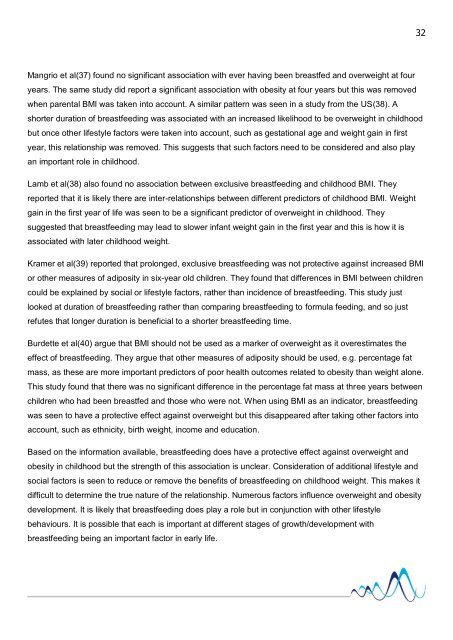Infant Feeding in Leicester City - East Midlands Public Health ...
Infant Feeding in Leicester City - East Midlands Public Health ...
Infant Feeding in Leicester City - East Midlands Public Health ...
You also want an ePaper? Increase the reach of your titles
YUMPU automatically turns print PDFs into web optimized ePapers that Google loves.
32Mangrio et al(37) found no significant association with ever hav<strong>in</strong>g been breastfed and overweight at fouryears. The same study did report a significant association with obesity at four years but this was removedwhen parental BMI was taken <strong>in</strong>to account. A similar pattern was seen <strong>in</strong> a study from the US(38). Ashorter duration of breastfeed<strong>in</strong>g was associated with an <strong>in</strong>creased likelihood to be overweight <strong>in</strong> childhoodbut once other lifestyle factors were taken <strong>in</strong>to account, such as gestational age and weight ga<strong>in</strong> <strong>in</strong> firstyear, this relationship was removed. This suggests that such factors need to be considered and also playan important role <strong>in</strong> childhood.Lamb et al(38) also found no association between exclusive breastfeed<strong>in</strong>g and childhood BMI. Theyreported that it is likely there are <strong>in</strong>ter-relationships between different predictors of childhood BMI. Weightga<strong>in</strong> <strong>in</strong> the first year of life was seen to be a significant predictor of overweight <strong>in</strong> childhood. Theysuggested that breastfeed<strong>in</strong>g may lead to slower <strong>in</strong>fant weight ga<strong>in</strong> <strong>in</strong> the first year and this is how it isassociated with later childhood weight.Kramer et al(39) reported that prolonged, exclusive breastfeed<strong>in</strong>g was not protective aga<strong>in</strong>st <strong>in</strong>creased BMIor other measures of adiposity <strong>in</strong> six-year old children. They found that differences <strong>in</strong> BMI between childrencould be expla<strong>in</strong>ed by social or lifestyle factors, rather than <strong>in</strong>cidence of breastfeed<strong>in</strong>g. This study justlooked at duration of breastfeed<strong>in</strong>g rather than compar<strong>in</strong>g breastfeed<strong>in</strong>g to formula feed<strong>in</strong>g, and so justrefutes that longer duration is beneficial to a shorter breastfeed<strong>in</strong>g time.Burdette et al(40) argue that BMI should not be used as a marker of overweight as it overestimates theeffect of breastfeed<strong>in</strong>g. They argue that other measures of adiposity should be used, e.g. percentage fatmass, as these are more important predictors of poor health outcomes related to obesity than weight alone.This study found that there was no significant difference <strong>in</strong> the percentage fat mass at three years betweenchildren who had been breastfed and those who were not. When us<strong>in</strong>g BMI as an <strong>in</strong>dicator, breastfeed<strong>in</strong>gwas seen to have a protective effect aga<strong>in</strong>st overweight but this disappeared after tak<strong>in</strong>g other factors <strong>in</strong>toaccount, such as ethnicity, birth weight, <strong>in</strong>come and education.Based on the <strong>in</strong>formation available, breastfeed<strong>in</strong>g does have a protective effect aga<strong>in</strong>st overweight andobesity <strong>in</strong> childhood but the strength of this association is unclear. Consideration of additional lifestyle andsocial factors is seen to reduce or remove the benefits of breastfeed<strong>in</strong>g on childhood weight. This makes itdifficult to determ<strong>in</strong>e the true nature of the relationship. Numerous factors <strong>in</strong>fluence overweight and obesitydevelopment. It is likely that breastfeed<strong>in</strong>g does play a role but <strong>in</strong> conjunction with other lifestylebehaviours. It is possible that each is important at different stages of growth/development withbreastfeed<strong>in</strong>g be<strong>in</strong>g an important factor <strong>in</strong> early life.


